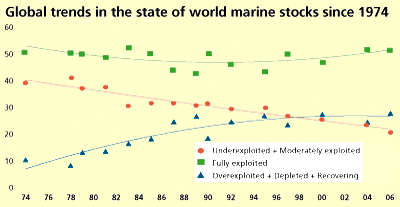According to the latest edition of the UN agency's The State of World Fisheries and Aquaculture (SOFIA), existing responsible fishing practices need to be more widely implemented and current management plans should be expanded to include strategies for coping with climate change.

"Best practices that are already on the books but not always implemented offer clear, established tools towards making fisheries more resilient to climate change," said Kevern Cochrane, one of SOFIA's authors. "So the message to fishers and fisheries authorities is clear: get in line with current best practices, like those contained in FAO's Code of Conduct for Responsible Fisheries, and you've already taken important strides towards mitigating the effects of climate change."
Vulnerable food systems and communities
Climate change is already modifying the distribution of both marine and freshwater species. Warmer-water species are being pushed towards the poles and experiencing changes in habitat size and productivity.
And climate change is affecting the seasonality of biological processes, altering marine and freshwater food webs, with unpredictable consequences for fish production.
For communities who heavily rely on fisheries, any decreases in the local availability of fish or increases in the instability in their livelihoods will pose serious problems.
“Many fisheries are being exploited at the top range of their productive capacity. When you look at the impacts that climate change might have on ocean ecosystems, that raises concerns as to how they'll hold up," said Cochrane.
Urgent efforts are needed to help fishery and aquaculture dependent communities to strengthen their resilience to climate change, especially those most vulnerable, he added.
Fishing's carbon footprint
Fisheries and aquaculture make a minor but significant contribution to greenhouse gas emissions during fishing operations and transport, processing and storage of fish, according to today's report.
The average ratio of fuel to carbon dioxide (CO2) emissions for capture fisheries is estimated at about 3 teragrams of CO2 per million tonnes of fuel used. "That could be improved. Good fisheries management can substantially improve fuel efficiency for the sector," Cochrane said. "Overcapacity and excess fishing capacity mean fewer fish caught per vessel—that is, lower fuel efficiency—while competition for limited resources means fishers are always looking to increase engine power, which also lowers efficiency."
Compared to actual fishing operations, emissions per kilogram of post-harvest aquatic products transported by air are quite high, SOFIA adds. Intercontinental airfreight emits 8.5 kg of CO2 per kilogram of fish transported. This is about 3.5 times that for sea freight and more than 90 times that from local transportation of fish where it is consumed within 400 kilometres of catch.
New production figures
Total world fisheries production reached a new high of 143.6 million tonnes in 2006 (92 million tonnes capture fisheries, 51.7 million tonnes aquaculture). Of that, 110.4 million tonnes was used for human consumption, with the remainder going to non-food uses (livestock feed, fishmeal for aquaculture).
The production increases came from the aquaculture sector, which now accounts for 47 per cent of all fish consumed by humans as food. Production in capture fisheries has levelled off and is not likely to increase beyond current levels.
Status of wild stocks

Nineteen per cent of the major commercial marine fish stocks monitored by FAO are overexploited, 8 per cent are depleted, and 1 per cent is ranked as recovering from depletion, today's report indicates.
Around half (52 per cent) rank as fully exploited and are producing catches that are at or close to their maximum sustainable limits.
Twenty per cent of stocks fall into the moderately exploited or underexploited category.
Areas with the highest proportions of fully-exploited stocks are the Northeast Atlantic, the Western Indian Ocean and the Northwest Pacific.
SOFIA identifies overcapacity—a combination of too many boats and highly effective fishing technologies— as a key problem affecting fisheries today.
Progress in tackling this issue has been slow, it says, and "there has been only limited progress in mainstreaming precautionary and ecosystem approaches to fisheries, eliminating bycatch and discards, regulating bottom-trawl fisheries, managing shark fisheries and dealing with illegal fishing."
Other findings
SOFIA paints a clear picture of the importance of fishing and aquaculture in the developing world.
An estimated 43.5 million people are directly involved, either full or part time, in capture fisheries and aquaculture. Most (86 per cent) live in Asia. An additional 4 million are engaged in the sector on an occasional basis. Factoring in employment in fish processing, marketing and service industries and including the families of all people employed directly or indirectly from fisheries and aquaculture, over half a billion people depend on the sector.
Fish provides more than 2.9 billion people with at least 15 per cent of their average per capita animal protein intake. It contributes at least 50 per cent of total animal protein intake in many small island developing states as well as in Bangladesh, Cambodia, Equatorial Guinea, French Guiana, the Gambia, Ghana, Indonesia and Sierra Leone.
Both direct employment and jobs in related industries are likewise important for developing countries, while their revenues from fisheries exports earn have reached $24.6 billion annually.
The world's motorized fishing fleet totals around 2.1 million vessels. The vast majority (90 per cent) measure under 12 meters in length. Some 23 000 are large-tonnage "industrialized" vessels. The nationality of several thousand of these is unknown—this “unknown” category has expanded in recent years in spite of global efforts to eliminate illegal fishing.
SOFIA also includes chapters on the occupational safety of fishers, seafood certification schemes, marine genetic resources, shrimp fishing, and the use of wild fish as seed and feed in aquaculture.
Discussions at FAO
Starting today, representatives of over 80 countries are gathering at FAO's Rome headquarters for the 28th session of the UN agency's Committee on Fisheries (COFI), where they will discuss the issues raised in SOFIA and the program of work for FAO's Fisheries and Aquaculture Department.



